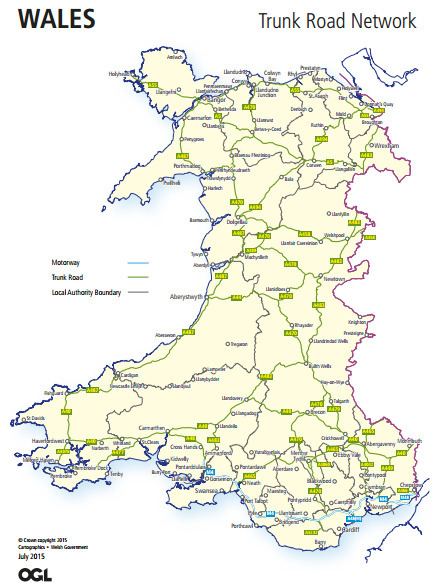 | ||
Trunk roads in Wales were first created in the Trunk Roads Act of 1936 when the UK Ministry of Transport took direct control over 30 of the principal roads in Great Britain from English, Welsh and Scottish local authorities. The number of trunk roads were expanded from 30 to 101 in the Trunk Roads Act of 1946. These roads formed what the Act called "the national system of routes for through traffic". Since Welsh devolution the Trunk Road system in Wales has been managed by the South Wales Trunk Road Agent and North & Mid Wales Trunk Road Agent on behalf of the Welsh Government. As of April 2015, out of a total of 34,495 miles (55,514 km) of roads in Wales, 1,576 miles (2,536 km) are trunk roads (including 133 miles (214 km) of motorways and 350 miles (560 km) of dual carriageway).
Contents
Historically, trunk roads have been listed on maps with a "(T)" after their number, to distinguish them from non-trunk parts of the same road. However, this suffix is no longer included on current Ordnance Survey maps. However, the North and Mid Wales Trunk Road Agent still use it to distinguish the trunk road from a non-trunk road. It is possible for roads to be "de-trunked" for example, when a road had been improved by a motorway, bypass or a similar route. When a road is de-trunked signposts are often replaced, and sometimes route numbers are changed, making the original road harder to follow. The London–Fishguard Trunk Road in 1936 only included the A48 and the A40. However, with road improvements (most notably the M4 motorway), the A48 in south Wales and A40 in England have largely been de-trunked.
Under UK Parliamentary control
The 1936 Act came into force in Wales on 1 April 1937 and created 30 trunk roads in Great Britain, with 5 roads either completely or partially within Wales. The Act excluded roads in the County of London and Northern Ireland. The 1946 Act came into force in Wales on 1 April 1946 and produced a further 71 with 11 either completely or partially within Wales. This Act included roads within the County of London, but still excluded the City of London.
A review of roads was carried out in 1997–98 by the Government of the United Kingdom. It reviewed the existing trunk road network and identified routes that were of national strategic importance. The factors for deciding which routes should be retained in the core (trunk) network included:
These factors were published in the Government's white paper "A New Deal for Transport" in July 1998.
Under Welsh Assembly control
The National Assembly for Wales took responsibility for devolved powers on 1 July 1999, as part of this process, transport was transferred from the Parliament of the United Kingdom to the National Assembly for Wales and with it responsibility for the trunk road network, including motorways. Responsibility for the management of highways in Wales is split between the Welsh Government and local highway agencies. The Welsh Government is responsible for trunk roads and motorways, whilst the 22 local authorities are responsible for all other highways.
In 2001 the Welsh Government reviewed the way in which trunk roads and motorways were being managed, and by September 2004, they had decided to reduce the number of trunk road agencies from eight down to three. The three new agencies were:
The three new Trunk Road Agencies started on 1 April 2006. Six years later on 1 April 2012 these were again reduced further down to two:
Neath Port Talbot County Borough Council and Gwynedd Council manage and maintain the trunk road network on behalf of the Transport and Strategic Regeneration division of the Welsh Government for SWTRA and NMWTRA respectively.
In March 2002, the Welsh Government developed their Trunk Road Forward Programme. The programme listed plans for major improvements and new road schemes. Following the 2004 review of the Welsh Government's transport policy in 2004, they updated the list for major improvements and new road schemes. In December 2008 the Trunk Road Forward Programme was again updated due to the pledges made in the One Wales the Labour Party and Plaid Cymru.
As of April 2015, out of a total of 34,495 miles (55,514 km) of roads in Wales, 1,576 miles (2,536 km) are trunk roads (including 133 miles (214 km) of motorways and 350 miles (560 km) of dual carriageway).
